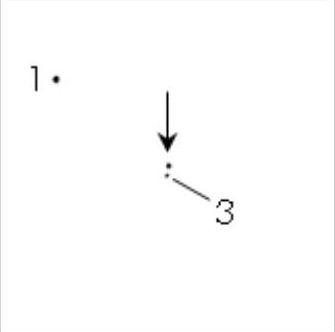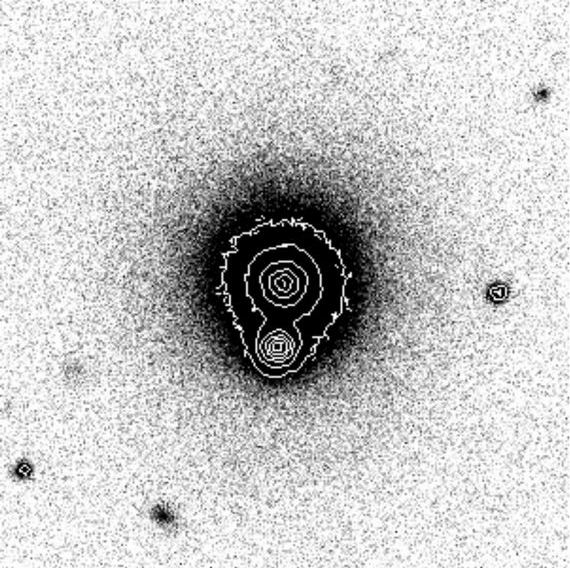
| Frankfurt Quasar Monitoring |
| MRK 180 |
| Cross-Identifications | PGC 35899, VII Zw 412, ZWG 334.43, 1133+704 TXS 1133+704, RGB J1136+701, GB6 J1136+7009 CGPG 1133.5+7027, 2MASX J11362642+7009268 S5 1133+70, QSO B1133+704, RX J1136.5+7009 RBS 1002, XSS J11349+6944, 1E 1133.5+7026 7C 113332.70+702557.00, 1FGL J1136.6+7009 1ES 1133+704, RX J1136.5+7009 |
| Equat. coordinates | RA 11 36 26.5 DE +70 09 28 (J2000) |
| Constellation | Draco |
| Type | BL Lac |
| Redshift (1) | z=0.046 |
| Distance (2) (3) | 185 Mpc |
| Total mag range (mv) (4) | 14.3 - 15.4 |
| Catalog Magnitude (1) | 14.49 |
| Absolute Magnitude (1) | -22.1 MB |
| Light Travel-Time (2) | 0.591 × 109 yrs |

Comparison stars
| star | B | V | Rc |
| 1 | 14.49 (0.02) |
13.98 (0.02) |
13.73 (0.02) |
| 2 | 15.36 (0.03) |
14.80 (0.02) |
14.41 (0.02) |
| 3 | 16.13 (0.04) |
15.49 (0.04) |
15.13 (0.02) |
| 4 | 16.55 (0.03) |
16.00 (0.03) |
15.66 (0.04) |
 Credit: DSS2R /
Size 4´× 4´
Reduced
contrast shows thestar-like nucleus of MRK 180 (arrow), together with comparison stars #1 and #3 |
 Credit: DSS2B /
Size 4´× 4´
The
same field section:enhanced contrast shows the elliptical host galaxy (phot. diam. 0.7´× 0.5´) |
 Credit: Nilsson et
al. (2003)
The
host galaxy of MRK 180:High resolution R-band image by the Nordic Optical Telescope (image size 56.9" × 56.9") |

| Markarian 180
(MRK
180 for short) is a bright BL Lac object in the eastern part of Draco,
only about 1° N of Lamda Draconis.
The
host galaxy (PGC) is thought to be an elliptical galaxy with an
apparent diameter of 0.7´× 0.5´ (see images above). MRK 180 was
discovered by swiss-born astronomer Fritz Zwicky (Zw), who described it
as a "red fuzzy sperical compact, in contact with star or very compact
spiral". The designation MRK 180
refers to the UV-Continuum-Survey run by Markarian et al. (MRK),
searching for blue galaxies with excessive UV-emission. In 1976, MRK
180 was identified as a BL
Lacertae-like object by spectral analysis. Later on, it was found that MRK 180 is also a source of radio
emissions (detected by the 5-Ghz Survey (S5)). In addition, MRK 180 is also an emitter of both X-rays (EXOSAT, ROSAT (RX)) and gamma rays (Fermi). MRK 180 is a small amplitude variable with a total range of about 1 magnitude in the optical. Visual observers with telescopes of 10- to 12-inch of aperture spot a stellar or star-like object at low power. With higher powers, or better with larger apertures, MRK 180 presents itself as a tiny diffuse object with a star-like nucleus. Just 6.3 arcsec south of the nucleus we find a faint star of mag 15.49, earlier described by Zwicky. This star, given as comparison star #3 (see table above), may interfere with the light from MRK 180 during photometric reduction. CCD observers, as well as visual observers, shall use the comparison stars given above. ____________
Starting
our visual trip into the surrounding star field we first meet pretty
bright
edge-on galaxy NGC 3735,
only 30´ N of MRK 180. The nucleus of NGC
3735 shows a Seyfert 2-spectrum, and was therefore classified as an
AGN. Turning 3.5° E we find the large 10.7-mag galaxy NGC 4236. But
don´t be fooled: what looks like an easy task for telescopes of 8- to
10-inch of aperture turns out to be a tough nut even for large
apertures. Actually, NGC 4236 is a low surface brightness galaxy,
spreading its faint light over a huge area of 22´× 6´. So you need very
dark skies to spot this SBdm-type spiral, a member of the M81-galaxy
group. CCD observers will easily detect the faint edge-on galaxy UGC 6580, some 6 arcmin SE of MRK 180 (see finding chart above). UGC 6580 is a faint B=15.7 mag Sb-c spiral with an apparent diameter of 1.0 × 0.15 arcmin. Observers who like to track down some more quasi-stellar photons may turn to quasar PG 1351+640, a bright 14-mag object at a distance of about 1.1×109 light-years, some 14.7° ESE of MRK 180. Finally, another bright 14-mag quasar, PG 0804+761, is located some 15° NW, at a distance of about 1.2×109 light-years. |
| Angel, J.R.P., Stockman, H.S. 1980, ARA&A, 18, 321; Optical and infrared polarization of active extragalactic objects. Colla, G., Fanti, C., et al. 1972, A&AS, 7, 1; The B2 Catalogue of radio sources - second part. Dixon, R.S., Kraus, J.D. 1968, AJ, 73, 381; A High-Sensivity 1415 MHz Survey at North Declinations between 19 and 37 degrees. Fiorucci, M., Tosti, G. 1996, A&AS, 116, 403; VRI photometry of stars in the fields of 12 BL Lacertae objects. Fiorucci, M., Tosti, G. 1996, A&AS, 117, 475; Automatic optical monitoring of 10 Blazars. Katajainen, S., Takalo, L.O., et al. 2000, A&AS, 143, 357; Tuorla quasar monitoring I. Observations of 1995-1997. Kinman, T.D. 1976, ApJ, 205, 1; Photoelectric Magnitudes and Polarization Data for possible BL Lacertae Objects. Markarian, B.E. 1969; Astrofizika 5, 443; Galaxies with Ultraviolet Continuum II. Moles, M., Garcia-Pelayo, J.M., Masegosa, J., Aparicio, A. 1985, ApJS, 58, 255; BVRI observations of BL Lacertae objects. Nilsson, K., Pursimo, T., et al. 2003, A&A, 400, 95; R-band imaging of the host galaxies of RGB BL Lacertae objects. Pica, A.J., Smith, A.G., et al. 1988, AJ, 96, 1215; Long-term optical behavior of 144 compact extragalactic objects - 1969-1988. Rector, T.A., Stocke, J.T. 2001, AJ, 122, 565; The Properties of the Radio-Selected 1 Jy Sample of BL Lacertae Objects. Sowards-Emmerd, D., Romani, R.W., et al. 2005, ApJ, 626, 95; Northern Survey of Gamma-Ray Blazar Candidates. Steinicke, W.; Katalog heller Quasare und BL Lacertae Objekte; Umkirch 1998. Stickel, M., Fried, J.W., Kühr, H. 1993, A&AS, 98, 393; The complete sample of 1 Jy BL Lac objects. II. Véron-Cetty, M.-P., Véron, P. 2001, A&A 374, 92; A Catalogue of Quasars and Active Nuclei: 10th edition. Véron-Cetty, M.-P., Véron, P. 2003, A&A 412, 399; A Catalogue of Quasars and Active Nuclei: 11th edition. Véron-Cetty, M.-P., Véron, P. 2006, A&A 455, 776; A Catalogue of Quasars and Active Nuclei: 12th edition. Véron-Cetty, M.-P., Véron, P. 2010, A&A 518, 10; A Catalogue of Quasars and Active Nuclei: 13th edition. Villata, M., Raiteri, C.M., et al. 1998, A&AS 130, 305; BVR photometry of comparison stars in selected blazar fields, I: Photometric sequences for 10 BL Lacertae objects. Wills, D., Wills, B.J. 1976, ApJS, 31, 143; Spectroscopy of 206 QSO candidates and radio galaxies. Zekl, H., Klare, G., Appenzeller, I. 1981, A&A, 103, 342; Optical Brightness Variations of BL-Lacertae Objects. |
| Links: Landessternwarte Heidelberg Chara/PEGA |
| home |